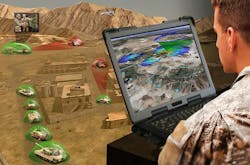Raytheon pursues Army electronic warfare (EW) RF spectrum management with offensive cyber warfare
Officials of the U.S. Army Contracting Command at Aberdeen Proving Ground, Md., announced a $49 million order Wednesday to the Raytheon Space and Airborne Systems segment in Fort Wayne, Ind., to develop the Electronic Warfare Program Management Tool (EWPMT) capability drop 4 (CD4), as well as to maintain and help field EWPMT CD3 and CD4.
EWPMT is a battlefield planning and battle-management system to help managing jamming of enemy communications, remotely controlled explosives, radar systems, and other RF assets while safeguarding U.S. and allied RF systems. It helps Army electronic warfare officers plan, coordinate, manage, and de-conflict unit EW activities.
The EWPMT, which is part of the Army's Integrated Electronic Warfare System (IEWS), is designed to help Army officers coordinate distributed EW systems tied together on tactical networks, help align EW systems with artillery and mortar installations, as well as help synchronize air and ground electromagnetic spectrum operations.
EWPMT features an open architecture that can be customized for different services and operating environments. It has been an Army program of record since 2014.
EWPMT capabilities include producing EW orders and estimates, planning and employing EW assets, conducting EW targeting with weapons and jammers, and conducting EW battle damage assessment.
The system provides risk assessment and recommends courses of action for EW missions with software applications and tools that act as a set of services to be run on command post computers and computer networks.
The EWPMT program consists of four increments or capability drops. The first, fielded in 2016, visually indicates enemy RF resources that warfighters can jam; what is being jammed; what is emitting; what the enemy emitter looks like; what it might look like to plan around the enemy’s emitting capability; and a strategy for jamming the enemy to allow for physical maneuver in the terrain.
EWPMT capability drop 2 works similarly to air traffic control systems helping airliners avoid collisions; it enables commanders to detect, identify, and manage signals in the crowded electromagnetic spectrum. It also offers stand-alone embedded training to enable users to simulate a real deployed environment for training.
Capability drops three and four are related to spectrum management and cyber situational awareness through a follow-on capability called Cyber and Electromagnetic Battle Management (CEMBM), which integrates cyber and electromagnetic spectrum awareness capabilities into the EWPMT.
These enhancements will enable battlefield commanders to exploit detected cyber vulnerabilities of enemy sensors in the field, as opposed to simply jamming them.
While EWPMT focuses on the ability to see and understand electromagnetic events, the CEMBM provides a shared situational understanding of electronic warfare, electromagnetic spectrum, and cyber warfare, and how to manage and control these systems.
Related: General Dynamics to maintain and upgrade Army SIGINT and electronic warfare (EW) vetronics
CEMBM can enable electronic warfare officers to determine how to carry out electronic and cyber warfare operations without being jammed or discovered; jam enemy communications; and disrupt cyber emitters.
On this order Raytheon will do the work in Fort Wayne, Ind., and should be finished by September 2022. For more information contact Raytheon Space and Airborne Systems online at www.raytheon.com, or the Army Contracting Command at Aberdeen Proving Ground at http://acc.army.mil/contractingcenters/acc-apg.
Ready to make a purchase? Search the Military & Aerospace Electronics Buyer's Guide for companies, new products, press releases, and videos
